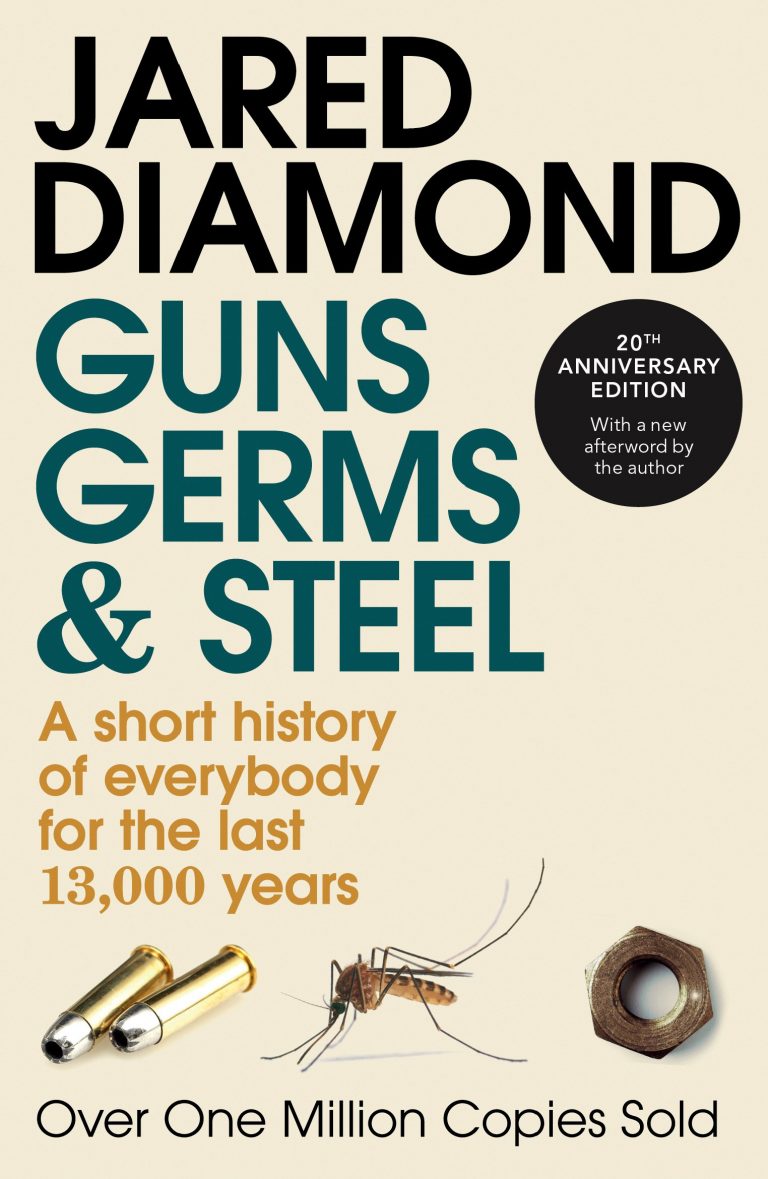Guns, Germs and Steel is a seminal book by the ethnographer Jared Diamond. At its core, it is a multi-disciplinary study of why the west has overtaken the world.
Jared Diamond starts off with a simple question—one that was posed to him by a Papua New Guinean politician, Yali—”Why is it that you white people developed so much cargo and brought it to New Guinea, but we black people had little cargo of our own?” The word “cargo” here referred to steel tools, soft drinks, clothing, utilitarian apparatus and everything that we consider to be part of the fabric of a modern society.
Many earlier studies, especially those published during late 19th century, concluded that the caucasian race had much superior genes and that they possessed better intelligence than most other races. Such a hypothesis does not hold well to today’s standards of scientific rigour. Jared Diamond, adhering to modern scientific standards, not only throws that assumption out but also puts forward counter arguments. He observes that intelligence manifests itself in ways that is conducive to the individual’s survival in the environment that he dwells. As such, individuals from different societies are not different in terms of their intellectual abilities.
He resorts to analysing the course of history like an anthropologist and a historian to isolate and articulate the decisive factors that have caused the power disparity in the various societies as we know today.
The book itself is divided into four parts.
The first part sets up the premise using three discourses. The first of which is a brief history of human migration. Using available carbon-dating data of pre-historical sites, he constructs a distribution of human population and the corresponding timelines of human inhabitation across the entire landmass of Earth. It is followed by a writeup about power struggles in Polynesia. This acts more like a miniaturised example of multi-ethnic conflicts where each group has diverse population densities owing to geography and thus operate using different complexity of societal structures. Finally, he uses the Spanish Inquisition of Latin America as an example where a handful of men wiped out an empire intentionally using guns and unintentionally using smallpox.
The second part of the book focuses specifically of the development of agrarian societies. The driving argument is that the rise of agrarian societies caused specialisation of skill in human resources. This in turn helped egalitarian communes evolve into kleptocratic societies—one with a power hierarchy and some form of military power. Jared Diamond substantiates this with a few historical observations that exposes the staggered timelines (or head-start for a few societies) of plant and animal domestication in various societies and their spread across the landmass. One powerful observation is the rapid spread of farming technologies along latitude owing to similar climate when compared to spread along longitude. This specifically benefits the Eurasian landmass that is oriented East-West unlike Africa of the Americas.
The third part is where the crux of his arguments play out. In four different chapters, Jared Diamond touches upon the evolution of germs, writing, technology and complex societies. The societies of the Western part of Eurasian landmass seemed to have a lot of head start in developing all of these. This gave them dominant power over other societies that were no match when an eventual conflict occurred. Between 16th century to 20th century, the reigns of imperialism and the notion of racial supremacy in these societies crushed many other societies and their people—the effects of which are still visible in many non-European countries.
The final part is a group of case studies from various parts of the globe. While most of these substantiate Jared Diamond’s hypothesis, I must highlight a puzzling chapter that reads, “Who are the Japanese?” The author himself states that he is baffled by the anomaly of a society that apparently has no cultural or linguistic links to its neighbours. He attributes part of it to the construct myth in which the Japanese population considers its emperors direct descendants of the sun goddess and elevates the people to a superior lineage of the supernatural. The elaborate myth even contains constructed stories to fill in logical and historical voids. Although there is a hypothesis that the Koreans and Japanese share a lot of common ancestry, any research into that is nearly impossible owing to the cultural and racial supremacy claimed by either of these ethnicities. This causes a lot of disruption in unearthing true findings from archeological expeditions.
In my opinion, Guns, Germs and Steel it is an important book and must be read by anyone interested in anthropology, history or sociology. If anything, it sheds a lot of light into the societies we live in and what might have shaped them. I was able to apply the concepts and deduce the power hierarchies of smaller societies (and India has a lot of diversity for my thought experiments) as well as in corporate world.

